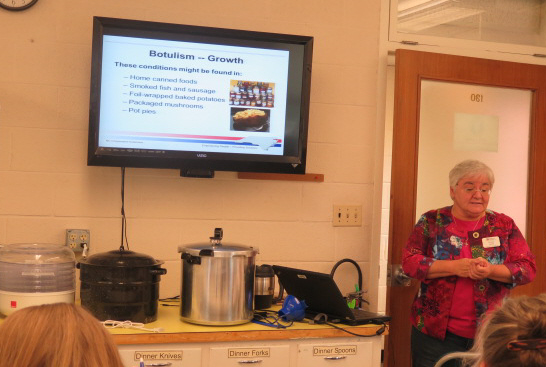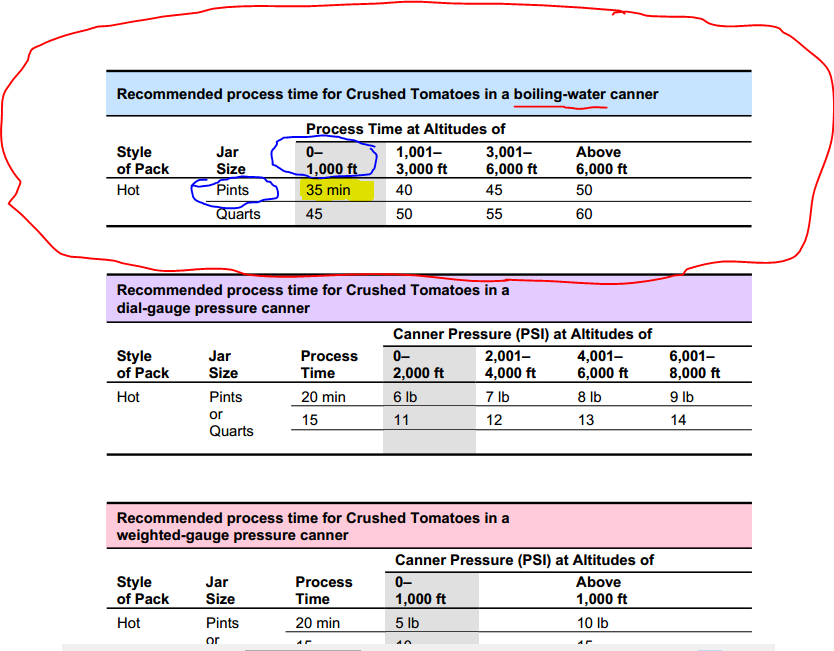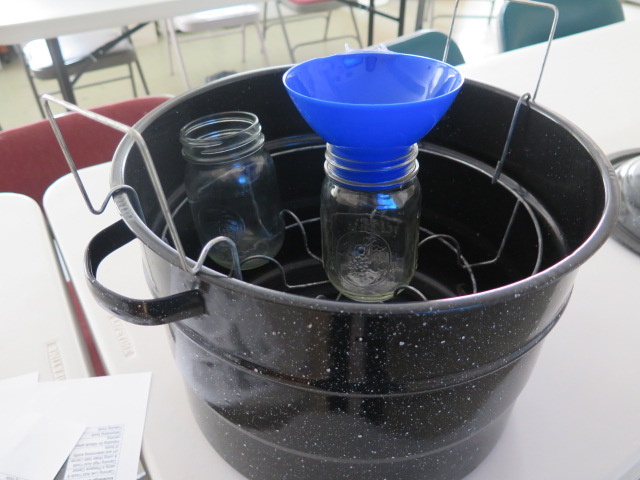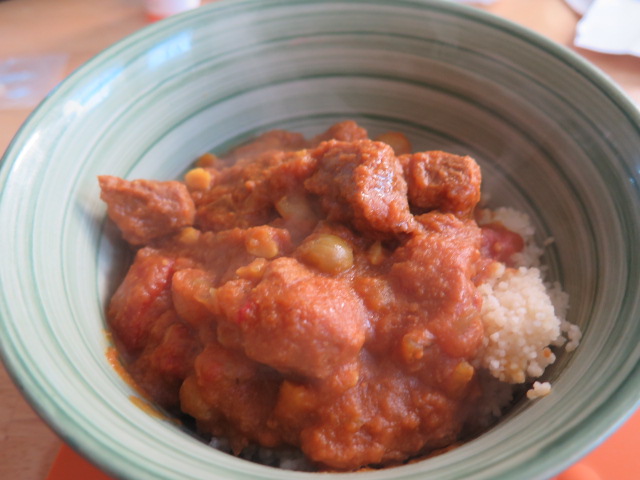
By Ciranna Bird, CFSA Member and Medical Writer for Farmers
Seek the experts
Home-canning expertise used to be handed down through generations. For example, my dad and uncles learned how to hunt deer with compound bows, shoot wild ducks and fish for rainbow trout in the Colorado River from my grandpa. My grandmother taught my Aunt Pat how to home-can trout, as well as the vegetables and fruit they grew in their yard. Unfortunately, I lost contact with my dad and his side of the family for fourteen years, after my parents’ divorced. Since I didn’t grow up with this culture of food self-sufficiency or even have the desire to learn how to be a home-canner at that time, I like many adults my age am looking for ways to learn these skills. Where can we start?

Chatham Co Cooperative Extension Safely Preserving at Home class
Based on my excellent experience attending a class at the Chatham County North Carolina Cooperative Extension service, I would recommend your local Cooperative Extension Service county center. Visit https://www.ces.ncsu.edu/local-county-center/ if you live in North Carolina and http://www.clemson.edu/extension/county/index.html if you live in South Carolina to search for the office nearest your home. The Cooperative Extension Service offers free testing of your pressure canner gauges as well as affordable and informative courses.
Check out Part 1 of this series to gain 5 more motives to embrace home-canning.
Research the process
In the “Safely Preserving at Home” course, family and consumer sciences extension agent, Phyllis Smith, shared the most up-to-date, research based information on how to safely home-can vegetables and fruits. The participants of the workshop were a mix of newbies like myself and experienced home-canners. We walked away with copies of the 37th edition of Ball’s Blue Book Guide to preserving, handouts describing the parts of a typical pressure canner, frequently asked questions, and electronic resources that have the most current instructions and tested canning recipes. The interactions and questions during the class revealed that there was new information to learn even for those with prior years of hands-on experience.

New scientific research, newer models of canners, and a better understanding of the ways to reduce foodborne illness, all have resulted in improved and safer recipes and methods over the years. To benefit from all the progress made, it is important to seek out the most up to date guidance from a trusted source. I emphasize the word trusted because I recently found a canning book for home-canners that was published in 2011, which prided itself on skipping vital safety steps.
For my piece of mind, I encourage the readers of this article to use the United States Department of Agriculture (USDA) Complete Guide to Home Canning. Scientists and researchers at the USDA and Cooperative Extension Service universities, including Clemson University and North Carolina State University, have spent years developing the perfect the process of preserving tomatoes in glass jars.
They have identified the bacteria, yeasts, and mold that cause spoilage in tomatoes and identified the exact temperature and amount of time needed for processing and cooling to destroy them. In their research laboratories, scientists use the same size canners and same size glass jars that are available to the public.
These men and women from the USDA and Cooperative Extension services have tested thousands of variables (are the tomatoes packed into the jar raw or hot? Are there pieces of tomato in the jar or is it just the tomato juice? Are the tomatoes canned in a pint-sized jar or a quart-sized jar? Are you using a boiling-water canner or a pressure canner? Etc.) to identify the ideal conditions for home-canning our food safely..
CFSA is growing a regional food system that is good for consumers, good for farmers and farmworkers, and good for the land. Join CFSA’s Perennial Givers Guild and your monthly donation of any amount will help us grow local & organic from seed to plate.
Follow the recipe
Home-canning recipes must be followed exactly as written. Canning food is different than preparing a meal that you will eat within a few days. When you add the wrong ingredients or try out a new recipe for a meal you risk the chance that the food might not taste as good as you hoped it would.
In the home-canning world, if you substitute ingredients, attempt to double or halve the recipe, fail to reach the target temperature for the exact time the stakes are higher. The jars may not seal properly which could lead to food spoilage and waste. Worse, if the bacterial spores that produce botulinum toxin aren’t destroyed, eating the canned food which may look and smell perfectly normal may lead to paralysis and death.
At this point you might be saying “Wait a minute! My Aunt Pat (you can fill in the blank here) has been canning almost her whole life. She hasn’t ever used a recipe and she’s perfectly fine. Nobody has gotten sick from eating the canned food she prepares.” I don’t have a good response to this reasoning. I’m grateful that my Aunt Pat who still home-cans is alive and well in Colorado. I also feel passionate about sharing information with the readers of this article about the value of following up to date, trustworthy recipes exactly as they are written.
A recipe for making crushed tomatoes with no added liquid
To keep this recipe simple and provide the exact processing time, I have chosen the following options: The processing time listed below is specific for the use of a boiling-water canner. The processing pressure and time are different if you are using a pressure-canner. The processing time below is specific for the use of pint-sized jars with a boiling-water canner. The processing time for boiling-water canners is longer if you use quart-sized jars. A pint is equal to 2 cups; a quart is equal to 4 cups of food. The processing time below is specific for the use of pint-sized jars with a boiling-water canner in places where the elevation level is less than 1,000 feet above sea level. The processing time for boiling-water canners is longer if you live in mountainous regions. To find out the elevation level of your county view the North Carolina Topographic Map at http://geology.com/topographic-physical-map/north-carolina.shtml or the South Carolina Topographic Map at http://geology.com/state-map/south-carolina.shtml.

USDA Guide 3 Tomatoes and Tomato Products page 7
1. Harvest or buy 14 pounds of organic tomatoes from your local farmer:
Size: medium to large
Color: Any color (yellow, purple, pink, green, orange, striped, red, etc.)
Shape: Any shape (Round, funny-looking, pumpkin shaped, pointy, etc.)
Condition: Firm tomatoes picked from living tomato vines. It is tempting to think that it is okay to use soft over-ripe tomatoes since they are going to be softened by the canning process anyway. However over-ripe tomatoes are soft because of the enzymes, bacteria, yeast, and mold that are breaking them down. Choose plump, firm and good-smelling tomatoes to ensure the best taste and safest product.
2. Gather your instructions, equipment and ingredients
Visit your local Extension Service to get a hard copy or download the most recent version of the following USDA Home-Canning guidance material at http://nchfp.uga.edu/publications/publications_usda.html. Download Guide 1 – Principles of Home Canning and Guide 3 – Selecting, Preparing and Canning Tomatoes and Tomato Products
- Lemon juice (9 tablespoons) or citric acid (2 and ¼ teaspoons)
- A boiling water canner (16 quarts or larger)
- Nine mason jars – pint-sized, heat-tempered glass
- A canning rack to hold the glass jars
- Two-piece vacuum caps that fit the mason jars (1) unused metal lids with the sealing compound on the outer edge and (2) metal screw bands
- Thermometer
- Large cooking pots
- Cutting board and knife
- Wooden mallet or spoon
- Clean dish clothes and paper towels
- Jar lifter
- Canning funnel
- Plastic spatula or bubble remover
- Headspace tool or measuring tape
- A magnetic wand to remove and attach lids

Canner funnel with elevated rack
3. Prepare the jars, lids, and canner
Follow the instructions in Guide 1, pages 14 and 15.
4. Prepare the crushed tomatoes
Follow the instructions in Guide 3, page 7.
5. Fill one hot jar at a time:
a) Add 1 tablespoon of lemon juice or ¼ teaspoon of citric acid to the bottom of the hot pint-sized jar according to Guide 3 page 5.
b) Fill the hot jar with the hot tomatoes and leave exactly ½ inch of unfilled space in the jar between the food or liquid and the rim of the jar (Guide 3 page 7). This space is called the headspace and allows the food to expand and form a vacuum seal.
c) Remove air bubbles, food debris from the rim of jar, and add the lids. To see pictures and more detailed descriptions of how to do these steps refer to Guide 1 page 15-16.
d) Place the filled, sealed jar onto the canning rack that is elevated above the simmering 180 Fahrenheit degree water in the boiling-water canner.
e) Repeat steps a – d until all the jars have been filled.
6. Process the pint-sized jars with a boiling-water canner at an elevation of 1,000 feet or below sea level:
a) Lower the canning rack into the boiling-water canner which is already filled halfway with simmering water.
b) Follow the steps on Guide 1 page 18 to ensure a continuous time of 35 minutes of a rolling boil.
c) Follow the steps on Guide 1 page 18 to remove jars from the boiling-water canner.
7. Cool the jars for 12-24 hours.
Follow the instructions in Guide 1 page 25.
8. Check the jar seals.
Follow the instructions in Guide 1 pages 25-26.
Enjoy your delicious, local, organic canned tomatoes
Pop open a jar of your tomatoes, add your own seasonings, and use them to make lasagna, pizza sauces, stir-fry, stews and anything else you can think of. I’ll leave you with this quote from the NC Tomato Man, Craig LeHoullier: “I think that it is fair to say that we use our canned tomatoes in any cooked recipe – risotto, soups, stews – anything the commercial canned tomatoes goes into is improved if using our own home canned tomatoes.”

Beef Tajine with home-canned heirloom tomatoes
Ciranna Bird helps local farmers educate their customers on the health benefits related to small-scale pasture-based production of meat, dairy, and eggs. On July 21st, she will be presenting a workshop entitled “Protect your egg-laying hens and customers from Salmonella” at the Inter-Faith Food Shuttle. Registration is first come first serve. Information on her other speaking engagements, as well as her NC food blog, can be found at www.cirannabird.com.

